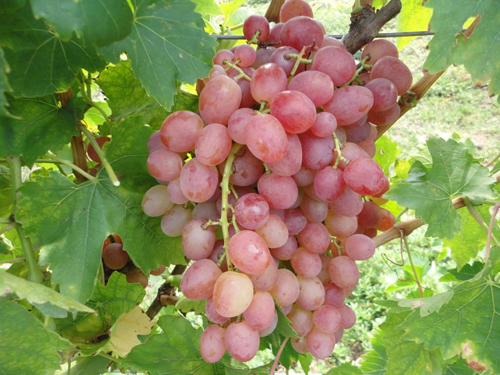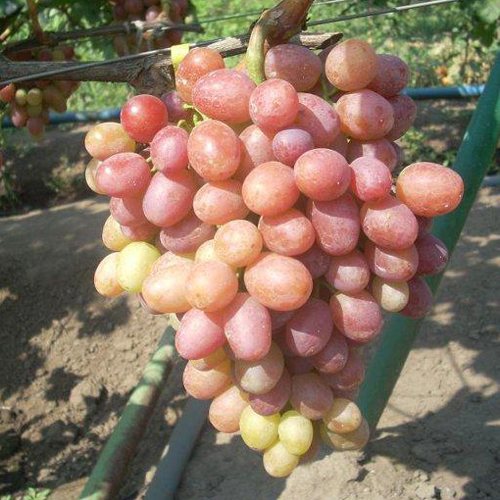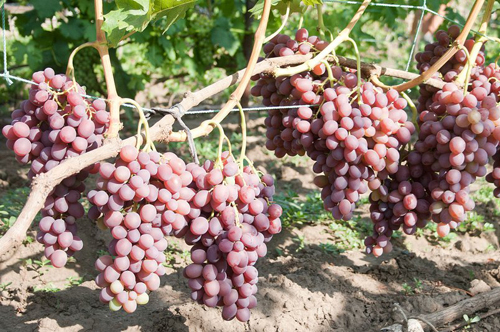Libya grape variety
Libya is a new, very promising popular grape variety, bred by the Ukrainian amateur breeder Vitaly Vladimirovich Zagorulko. At the same time, despite its "amateur" origin, the hybrid form quickly gained recognition at a very serious level. After the copyright was transferred to the Crimean Scientific Research Institute of Viticulture and Winemaking "Magarach", the hybrid passed a qualification examination literally in a year, and in 2011 it was entered into the state register of plant varieties of Ukraine, and in 2014 it was approved for use in the North -Caucasian region (Stavropol and Krasnodar Territories, Rostov Region, Republic of Adygea, Crimea, Dagestan, North Ossetia-Alania, Ingushetia, Kabardino-Balkarian, Chechen) and is included in the State Register of Breeding Achievements of the Russian Federation.

In his breeding research over Libya, Vitaly Zagorulko did not reinvent the wheel, taking as the maternal form a species convenient for cross-pollination with a functionally female type of flowering - Flamingo, and as a paternal form - the well-known and most popular Arcadia... As a result, an ultra-early ripe large-fruited hybrid of grapes with elegant berries of a pleasant pink color and an attractive aroma was obtained. Unfortunately, it was not possible to achieve outstanding results in frost resistance and disease resistance, but this in no way prevented the explosive growth of Libya's popularity among amateur winegrowers, and even, as we see, its recognition at the state level.
Agrobiological characteristics of the variety
The bushes have a fairly high vigor of growth, and those grown in a self-rooted culture are very vigorous. The crowns of young shoots are light green in color, they lack pubescence. The first leaf on the shoot is rounded, almost whole, the next ones are medium dissected, wide, five-lobed, without pubescence. The lateral notches on the leaf are open with parallel sides and a sharp bottom; the petiole is open lyre-shaped with a narrow aperture and a rounded bottom. The denticles along the edge of the leaf blade are large, triangular with a wide base. The yellowing of grape leaves in autumn begins from the edges. The flowers are bisexual, requiring no additional pollinators. Libya does not have a tendency to peel berries.

The bunches of this variety grow large - up to 25 cm long or more, with an average weight of 800-1200 grams with proper care. In shape - cylindrical-conical, sometimes branchy shapeless, in density - loose. The berries in the brush are free, not squeezed. The comb and stem of the berries are long, light green, strong. The berry is very large - 22 × 28 mm, with an average weight of 10-12 grams, obtuse, golden-pink or completely pink in color. Sometimes growers note an insufficiently intense color in comparison with the declared one, but here everything is individual and depends, most likely, on the climatic conditions of a particular season and region of cultivation. The pulp is dense, juicy and crunchy at the same time. Libya has a pleasant taste, with a harmonious combination of sugar and acid and a pronounced nutmeg aroma that lasts for a month after harvest. Uncolored juice. The skin is thin, intangible when consumed, covered with a layer of white pruin bloom. The seeds are medium-sized, well separated from the pulp, there are 2-4 of them in the berry. Bunches of this variety, due to their low density, can remain on the bush for a long time after ripening without the danger of decay. Grapes are not prone to cracking, but in wet years this problem can manifest itself. It should also provide for the protection of ripe berries from wasps.
The crop is intended for fresh consumption. It is one of the first to enter the market, has an excellent presentation, which makes it very popular with buyers.However, due to its thin skin, it is characterized by average suitability for transportation and storage of the harvested bunches. Requires careful and careful handling during collection and transportation.

Very early ripening variety. The growing season from the moment the buds open until the harvest reaches the removable maturity is a little more than 100 days. Libya manages to mature even in the northern regions, because a very small amount of active temperatures is enough for this - about 2100 ° C. It begins to bear fruit early, already in the third year it can please with the first bunches. The variety is characterized by moderate yields, but with proper care it can bear fruit very abundantly. Some winegrowers, according to their testimony, in favorable years managed to collect up to 25-30 kilograms of grapes from a bush. During the state test, the potential yield was estimated very high - 168 c / ha. The frost resistance of the variety is average, an uncovered vineyard can withstand cold temperatures down to -21 ° C. The ripening of the shoots is good, however, when the crop is overloaded, insufficient maturation of the vine may be noted. An annual ripe shoot is light brown in color. The number of fruiting shoots is 70-80%. The sugar content of berry juice is quite high - 18.8 grams / 100 ml, acidity - 6.2 grams / liter.
Agrotechnical features
To obtain a large number of good quality bunches, the grower must take the care of Libya responsibly. Careless attitude to the variety threatens not only the loss of the current year's harvest, but also the weakening of the plants themselves, which as a result may die in the winter.
First of all, it is required to think over and work out a scheme for protecting plantations from diseases and pests. This variety of grapes is not resistant enough to such harmful and ubiquitous fungal diseases as mildew and powdery mildew, and therefore requires regular treatment with fungicides during the growing season. It is unstable to phylloxera, which is why it reproduces in its own-rooted culture only in regions free from this soil pest. The rooting rate of cuttings is good. Compatibility with common rootstocks is also quite high.
It is necessary to form bushes of this variety according to covering or semi-covering schemes. Only in areas with warm winters is it possible to grow Libya on a high trunk, but even there it will not be superfluous to provide for a lightweight, sheltered lower tier in order to guarantee the restoration of the bush in the event of the death of its main part. Shelters, depending on the intensity of frost in winter, can be different in the degree of protection of the vine. The simplest way would be to huddle the grape bushes with soil from the rows. This option is suitable in regions with a consistently high snow cover, which serves as thermal insulation, but it is dangerous with the risk of peephole damping out in wet soil. For more severe conditions, multilayer shelters are better suited, in which the vine is stored in a thick layer of thermal insulation material of organic origin - leaves, straw, coniferous branches or reeds. Air-dry shelter also shows good results.
In addition, it is very important when growing Libya to monitor the optimal load of the bush with shoots and crops. Not only do overloaded bushes drastically reduce the quality of the bunches, there is also a high probability of insufficient maturation of the vine, which will inevitably affect the already not very high winter hardiness of the variety. The recommended load is 35-45 buds per bush, but it is not always worth relying on standard recommendations, but setting the load depending on the age and vital energy of a particular plant. You can choose the most varied length of pruning, because even the first eyes of this grape are quite fruitful.
Ripening bunches are not only not recommended to lighten, but vice versa, they are offered to shade to obtain a more intense color of the berries. For the same reason, Libya succeeds better in relatively northern regions than in the south, where the harvest ripens quickly in the heat and sun, without having time to get an attractive pink color, for which many of its fans love this grape.
Despite all these numerous nuances, it can be stated with confidence that over the years since its inception, Libya has taken place as a variety not only on paper, but has also been recognized and sincerely loved by a huge number of winegrowers. Such popularity is not born from scratch, which means that certain difficulties in growing grapes are more than compensated by the satisfaction of the result obtained. And this is the most important thing that is important for any productive agricultural crop.








